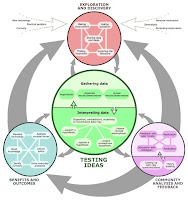Saturday, March 21, 2009
Free ebook_Light Hearted Approach to the Scientific Method and Project Management
Cogprints-eprints: Metadata Visibility matches "Always Show" AND Subjects matches "Decision Theory"
Conversations on the Search for a ‘Physics & Chemistry – an Alchemy’ of Innovation - Reward Systems. - Alexander, Mr James (2009) Conversations on the Search for a ‘Physics & Chemistry – an Alchemy’ of Innovation - Reward Systems. [Preprint]
It is also one of the approaches which led to my original blog title Conversation-on-Innovations
Friday, March 20, 2009
New look at the Processes of Science_How Science Really Works_A Big Picture.
 Step back for a minute and take a new look at our fundamentals as is said in rugby football circles.
Step back for a minute and take a new look at our fundamentals as is said in rugby football circles.No I am not asking the reader to embark on what can be seen as some unpleasant introspection of the human condition it's weakness or failure. On the contrary let's take a break from my/our current bandwagon of economic, climate and energy dilemmas if only to better our approaches to finding "sustainable solutions" to these very serious issues and to look at the positive and strong supportive role of science (in society).
"Science's Big Picture."
 A newly developed website has made understanding science, its processes, it's interactions and it's wide reach, a relatively simple, very attractive and enjoyable task. Although the site has been designed by teachers and lectures for teachers and includes elementary teaching resources, I firmly believe that the site will prove highly significant in clarifying the scientific method not as a linear process but as a system of interactions. It is, not only, a timely reminder and support for all professional in the science industry: a must for all scientists technologists, engineers including science communicators, be they scientists or laymen, but also to the general public, intrigued often worried by the influence of the scientific industry, its technology and engineering on their daily lives.
A newly developed website has made understanding science, its processes, it's interactions and it's wide reach, a relatively simple, very attractive and enjoyable task. Although the site has been designed by teachers and lectures for teachers and includes elementary teaching resources, I firmly believe that the site will prove highly significant in clarifying the scientific method not as a linear process but as a system of interactions. It is, not only, a timely reminder and support for all professional in the science industry: a must for all scientists technologists, engineers including science communicators, be they scientists or laymen, but also to the general public, intrigued often worried by the influence of the scientific industry, its technology and engineering on their daily lives.In fact we are all to some extent scientists, for science arises from observation: observation of our surroundings both the natural world and change as well as man's contribution, material products and systems.
Of course testing ideas remains central to the new presentation, but it's no longer a simple thumbs -up or thumbs-down on a hypothesis. Instead, the data need to be interpreted, and researchers are often forced to go back and either revise their hypothesis, or the assumptions on which the hypothesis is based. No matter what happens, the arrows in the diagram make it clear that the process must be viewed as a system with multiple rounds of testing and revision are needed to refine ideas.
More...
Sources
1. Ars Technica.com/
2. Understanding Science accessed on 20 March 2009. University of California Museum of Paleontology.
Monday, March 9, 2009
Solutions to global warming, air pollution, and energy security reviewed _Parametres used to classify and rank_Follows previous post

Its about energy and it's use. A multi-variable study by Mark Z. Jacobson in his “Review of solutions to global warming, air pollution, and energy security"
Twelve combinations of energy sources and vehicle type considered.
To place electricity and liquid fuel options on an equal footing, twelve combinations of energy sources and vehicle type were considered. The overall rankings of the combinations (from highest to lowest) were:
(1) wind-powered battery-electric vehicles (BEVs), (2) wind-powered hydrogen fuel cell vehicles, (3) concentrated-solar-powered-BEVs, (4) geothermal-powered-BEVs, (5) tidal-powered-BEVs, (6) solar-photovoltaic-powered-BEVs, (7) wave-powered-BEVs, (8) hydroelectric-powered-BEVs, (9-tie) nuclear-powered-BEVs, (9-tie) coal-with-carbon-capture-powered-BEVs, (11) corn-E85 vehicles, and (12) cellulosic-E85 vehicles.
The resultats are shown in the attractive graph opposite
Four Clear divisions of ranking, or tiers, emerge.
Tier 1 (highest-ranked) includes wind-BEVs and wind-HFCVs.
Tier 2 includes CSP-BEVs, geothermal-BEVs, PV-BEVs, tidal-BEVs, and wave-BEVs.
Tier 3 includes hydro-BEVs, nuclear-BEVs, and CCS-BEVs.
Tier 4 includes corn- and cellulosic-E85.
Nine electric power sources:
1. solar-photovoltaics (PV),
2. concentrated solar power (CSP),
3. wind,
4. geothermal,
5. hydroelectric,
6. wave,
7. tidal,
8. nuclear, and
9. coal with carbon capture and storage (CCS) technology.
Two Liquid Fuel Options.
1. corn-ethanol (E85) and cellulosic-E85.
Eight possible impacts of proposed energy-related solutions to global warming, air pollution mortality, and energy security considered which may impact on:
1.water supply,
2. land use,
3. wildlife,
4. resource availability,
5. thermal pollution,
6. water chemical pollution,
7. nuclear proliferation, and
8. undernutrition.
LCA_Life Cycle Analysis E
Effects on climate-relevant emissions
The CO2-equivalent (CO2e) emissions [emissions of CO2 plus those of other greenhouse gases multiplied by their global warming potentials] of each energy technology (11 types enumetated above) are reviewed. Jacobson also examines CO2e emissions of each technology due to planning and construction delays relative to those from the technology with the least delays ( opportunity-cost emissions ), leakage from geological formations of CO2 sequestered by coal-CCS, and the emissions from the burning of cities resulting from nuclear weapons explosions potentially resulting from nuclear energy expansion.
Source and Acknowledgement:
